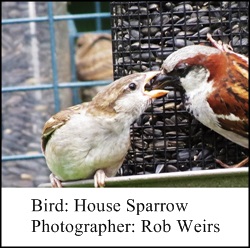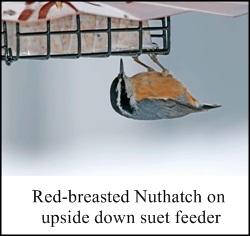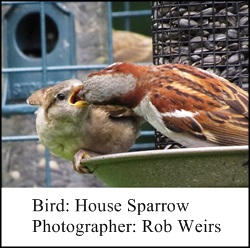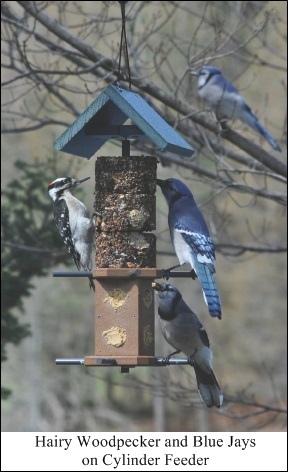At Wild Birds Unlimited in Grosse Pointe Woods, some of the most prevalent questions we are asked in late summer are, “What kind of seeds can I use that sparrows DO NOT like?” or, “What do I do about the house sparrows crowding out my other birds?”

House Sparrows can be found almost everywhere in this area, close to our homes and other buildings. They have a tendency to displace native birds from nest boxes, which causes some people to resent them. We must remember that because they have the ability to live so well among us, they are beneficiaries of our own success.
Identifying a House Sparrow should be easy. Look for the flock of birds that descend upon your feeders or gather in your shrubs and trees, chirping noisily in their sparrow language. I think they are letting others know where the latest feeders have been filled, so that the whole crowd may call others to the feast. Males change plumage this time of year, with their black bib becoming muted. Females and juveniles are perhaps the blandest bird in your yard with very little distinguishing characteristics other than being brown.
How do you attract House Sparrows? They will eat anything that you have to offer, from stale baked goods to the jelly that you put out for purposes of attracting Orioles. Any structure that has the ability for them to get inside will suit their purposes for breeding. In addition to using cavities or nest boxes for raising their young, they also use these spaces for shelter each day, adding materials that they gather for purposes of insulation. The House Sparrow is actually a Weaver Finch, not a true sparrow like our native White-throated Sparrows or Dark-eyed Juncos that visit our feeders.
So how do you limit the number of House Sparrows in your yard, if that is your goal? Make sure that your nest boxes have openings that are not larger than 1 ¼” or they will be able to get inside, precluding the House Wrens and Chickadees from using the nest box. If the opening is larger, place a metal protector over the entrance to deny them access. Look for places they gather and eliminate access to those places. Because they are not native to the United States, it is not illegal to disrupt their nesting. For example, it is perfectly acceptable to clean their nests out of your gutters before you add gutter guards. Observe them and you will be able to find their nesting spots and eliminate them by stopping their access to the area.
Keeping them out of feeders is another story altogether. For finch feeders, the answer is to trim your perches so that they are short enough for a Goldfinch to use and too large for a House Sparrows’ wider body to fit on the perch. What size would that be? Start with an inch long perch and modify down from there as needed. There is also a finch feeder where seed can only be accessed when the bird is hanging upside down. Goldfinches can do this easily whereas House Sparrows have a much more difficult time accomplishing this feat.
Using formed seed cylinders and cakes is also helpful in attracting Chickadees, Woodpeckers and Cardinals, all of which use their strong beak or ability to peck or pry a seed apart from the cylinder in order to feed. House sparrows are not as well equipped in this regard so it is not as easy for them to use seed cylinders. However, once the cylinder is crumbling apart, House Sparrows will be there to take advantage of the opportunity.
Feeding with plain suet is another way to attract quality, native birds such as Downy Woodpeckers and Black- capped Chickadees without being very attractive to House Sparrows. The suet cakes that have added seeds and peanuts are especially attractive to House Sparrows and should be avoided during this time of year if you are trying not to attract the post-breeding crowd of House Sparrows. There are suet feeders that allow only woodpeckers to reach the suet inside of the sandwich of the feeder, as well as suet feeders that can only be accessed from underneath, something more difficult for House Sparrows than it is for Woodpeckers and other clingers.
capped Chickadees without being very attractive to House Sparrows. The suet cakes that have added seeds and peanuts are especially attractive to House Sparrows and should be avoided during this time of year if you are trying not to attract the post-breeding crowd of House Sparrows. There are suet feeders that allow only woodpeckers to reach the suet inside of the sandwich of the feeder, as well as suet feeders that can only be accessed from underneath, something more difficult for House Sparrows than it is for Woodpeckers and other clingers.
If your yard is attracting a large flock of sparrows, it may be the scene of what some would consider entertainment. This is the time of year that young Sharp-shinned Hawks and Cooper’s Hawks are honing their hunting skills. House Sparrows will scatter like a bursting firework when one of these predatory birds decides they would make a good meal.
And on a different note, larger groups of birds are a great way to introduce small children to birds at a feeder. The commotion that is caused by a group of feasting House Sparrows is a good way for a toddler to be brought closer to Nature by watching the birds’ behavior. Perhaps birds that are flying over your yard will witness the flock of sparrows as well, and it will act as a welcome flag to those migrants.
Enjoy Your Birds !!
Have you joined our email list? Click here to sign up, it’s free and gives you access to sales, coupons, nature news, events, and more!


